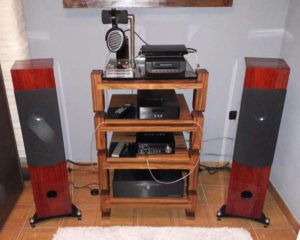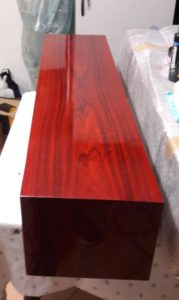Fabio, one of our customers from Italy, was in touch about his Eikona MLTL38 loudspeaker project. He requested permission to use the EJJ logo on his cabinets. Intrigued by this thoughtful finishing touch, we asked for details of his project. Here is what Fabio has to say:
Nothing is missing from the small Eikona 2, the coherence and the timbre are of the highest level ….. the speed of the transients will make you jump from the armchair, particularly on those majestic passages of great orchestral music …..
How can a single, 10 cm driver produce bass worthy of note? … in my room, it almost seems to have a subwoofer; nothing is missing, they are ideal for medium-small rooms.
LISTENING:
Martha Argerich and Friends – live from the Lugano Festival 2008: the violin and the piano are reproduced with grace and elegance, there is no difficulty in listening; the piano plays warm and round, while the violin is never harsh, the timbre is perfect and the speed of the Eikona is surprising.
Minnesota Orchestra – Showcase Eiji Oue – Reference Recordings: track no. 6 of this HDCD, literally leaves you speechless because it is “The Firebird Suite” by Stravinsky, in fact just listening to this piece, it seems to have a hidden subwoofer, it is impressive how these little drivers manage to reproduce the continuous bass drum beats in a as authoritative as it is lightning, without the sound of rumblings, “tails” and “blows”.
Tracy Chapman: well she is there in front of me with her deep and unique voice; one of the first CDs I listened to with these speakers was just this and I remember that in more than one passage I got goose bumps.
John Coltrane – Blue Train, Miles Davis – Kind of Blue, Michel Petrucciani – Live Blue Note: the instruments are real, alive, the details are heard until the last touch on the drums.
CONCLUSIONS:
These Eikonas will print a permanent smile on your face. I admit that I was initially doubtful about the choice, because in fact, it might seem that they are small, that they do not make it, and the cost, well … But there is an old saying goes, “in the small barrel there is good wine” – here this barrel does not contain wine but it will make you very euphoric.
I had some doubts that haunted me, but reading the reviews on EJ Jordan’s website and having an amplifier that is the ideal companion for these little gems, I embarked on this venture. I am not a technician in the field so I have tried to take care of all the details to get the most out of these objects that I now call “magic”. So with my friend Fabrizio we started the construction of the piece of furniture, taking care of all the details that a Hi-End speaker cabinet must have.
I have to say that after listening to them for a few days, one of the questions I asked myself was “but if a single driver can do so much, how will the larger Line Array sound?”
I’m not sure, but if in the future I have to have a larger environment in which to put my Hi Fi and a more muscular amp, I would definitely consider one of these projects.
DESIGN OF MY CABINETS:
I started from the design of the MLTL38 and keeping the volumes, I tilted the front and the rear panel by 5° trying to create fewer parallel faces. I inserted perforated bulkheads both to support the sound absorbency and to break down resonances, creating surfaces not parallel to the rest of the cabinet walls.
WOOD: a 26 mm thick Okoume plywood is very robust, multilayered and heavy.
SOUND ABSORBENCY: of the 3 internal sections that I created, I covered the first 2 starting from the top with sound-absorbing panels in bituminous material plus felt, about 1 cm thick (normally used to soundproof car bodywork).
As suggested by EJJ, I inserted a cylinder of sound-absorbing Dacron, behind the Eikona and another under the driver so that all unwanted midrange frequencies do not pass from the first volume to the other 2.
EXTERIOR FINISH: the cabinets were then veneered with real rosewood and impregnated with a red colour with subsequent transparent bottom and glossy varnish … many coats of glossy varnish!
To embellish the whole, I added aluminium plates with the technical characteristics. At the base I put a 5 mm black Plexiglas plate, a small wooden riser and then a 12 mm iron plate to which some decoupling tips were added. The part of the screw that came out of the plate was hidden with full aluminium feet used as a blind nut, which is very Hi End ….. in short, we Italians always have an eye on the finishing touches.






